Berneray
Berneray is an island in the Outer Hebrides (otherwise known as the Western Isles) off the west coast of Scotland. It is joined to the larger island of North Uist by a short double-track road causeway.
- For other places with the same name, see Berneray (disambiguation).
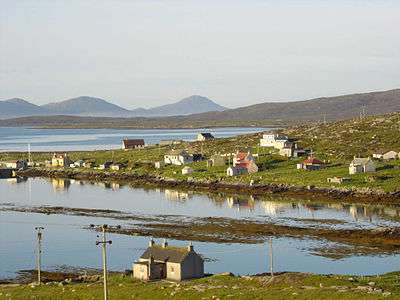
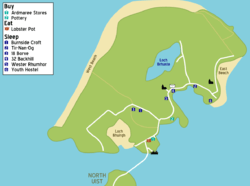
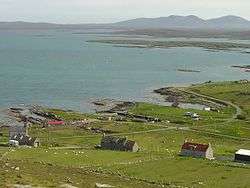

Understand
Berneray has a population of 137 (as of June 2010) which has been mostly rising for the previous three years.
Most people live on the east coast in the spread out settlements of Pol An Nor, Backhill, Ruisgarry and Sandhill. There is also a settlement in the center of the island known as Borve.
There is strong evidence that points to Berneray being inhabited since the Bronze Age and possibly before. The island is scattered with ancient sacred sites, stone circles, signs of Viking inhabitation and historical buildings, some several centuries old.
Crofting (family-based farming on a small area of land, usually in a non-intensive manner) and fishing are the mainstays of the economy, although tourism, information and media services also provide income to a number of households.
Due to the total lack of industrialization most visitors notice that most of the "noise" on Berneray is natural — waves, seals, geese and birds. Often the only audible human-made noise is the bell on the ferry that leaves the south of the island and crosses the Sound of Harris.
Berneray never becomes crowded or overrun with tourists due to the limited number of passengers that flights to the Outer Hebrides can take, as well as the high cost of bringing a vehicle over from the mainland on a ferry.
Landscape
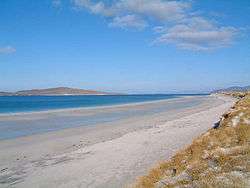
Apart from Boreray (population: 1), Berneray is the only inhabited island in the Sound of Harris, with an area of 10.1 km² (2496 acres). Berneray rises to a height of 305 feet (93 m) at Beinn Shleibhe (otherwise known as Ben Leva or Moor Hill) and 278 feet (85 m) at Borve Hill.
A key feature of Berneray is its machair, an area of land next to beaches and shorelines that has been fertilized over time by crushed shells and other minerals. Traditional crofting practice, which involves summer agriculture using seaweed together with dung from winter grazing animals as natural fertilizer, has, over time, bound together and stabilized the machair. In the summer months the fertile soil of the machair supports a spectacular and colourful array of wild flowers and plants.
Berneray is perhaps best known for its beaches. The famous west beach is a three-mile unspoilt, deserted crescent of sand. The east beach, at the end of which sits the Youth Hostel, is also spectacular, as are the little coves and beaches on the south side. All of these are good locations for a picnic, and for spotting otters and other sea life.
Even in the middle of summer it is very rare to see more than a few people on any stretch of Berneray beach.
Climate
The summer months of June to August have exceptionally long days (the latitude is comparable to the most populated regions of Scandinavia or Alaska), and also tend to be warmer. Due to its location, Berneray tends to have favoured warm air flows; the temperature very rarely goes below freezing, and snow occurs at most for one or two days per year.
However, sun and rain are possible at any time of the year. The months of April to May and September to October are favoured by many travellers. The days are still quite long and the weather is often excellent (better than the summer for the last two years).
Do not discount the winter, which has its attractions, for visiting. Key among them are the Northern Lights, a dazzling night-time display of shimmering curtains of different coloured light that stretches across the sky. The lack of light pollution makes Berneray an ideal place to view this event, as well as stars, meteors, comets and other astronomical features.
A resident of Berneray has a weather station that automatically feeds live data on-line.
Get in
By plane
The airport for the Uists is 🌍 Benbecula Airport (BEB IATA), about 25 miles south across the causeways. There are flights daily from Glasgow taking an hour, operated by Loganair. There are also flights (M-F) to Stornoway on Lewis: these connect to other destinations such as Edinburgh, but it's generally quicker to fly to Glasgow and take the train or other transport from there. The buses from Berneray towards South Uist run past the airport on Benbecula, taking an hour.
The alternative airports are Stornoway (SYY) on Lewis, and Barra (BRR). Reaching either involves a ferry crossing and a long drive.
By ferry
Calmac Ferries run from Leverburgh on Harris to Berneray. Ferries also run from Uig on Skye to Lochmaddy on North Uist, 10 miles by connecting bus from Berneray.
By bus
Regular buses (several every morning and afternoon, except Sunday) link Berneray with Lochmaddy on North Uist, and connect with other buses to islands further down the Outer Hebrides chain from there. Services W17 and W19 incorporate Berneray. It is possible to travel to several other islands connected by causeway and back in the same day from Berneray, thus enabling people to visit some of the many beaches. The latest timetables can be obtained from the Youth Hostel and the Berneray Shop; however the bus drivers are very helpful and will offer detailed local sightseeing and travelling advice.
By boat
Boat skippers can sail around the shallow waters of Berneray, and take shelter in the confusingly named Bays Loch. This is actually part of the sea (not a true Scottish Loch), but is relatively sheltered on most sides. On the east side of Bays Loch is the fishing harbour, with facilities such as a toilet and shower block, moorings, and a lifting crane. The exact location of the harbour is latitude 57 degrees 42m 50s, and longitude -7 degrees 10m 11s.
Get around
.jpg)
Berneray is some 2 miles wide and 3 miles long. There is a road along the east side of the island, and another through the centre and across the machair. These and the roads approaching Berneray are mostly single-track with occasional passing areas. Driving is easy, with very little traffic. The main obstacle are sheep that run into the middle of the road, and the occasional otter crossing.
Walking or cycling are popular ways of getting around. There is a circular path around much of the island that is clearly signposted with blue waymarker signs. Alternately, a popular walk is to follow the shoreline around the island, which takes around 5 hours. Most of the walk is on beaches. There may be slightly boggy areas of land after rain, so waterproof footwear is recommended. However, there are no dangerous areas of land; mud is the walkers greatest problem.
The hills of Berneray are relatively small, each taking about 15 minutes to walk up by a reasonably fit person. Despite their height, the views from the top are truly spectacular; on a clear day, it is possible to see up to 30 other islands, including St Kilda, and many other beaches.
There are no dangerous or poisonous animals on Berneray. Sheepdogs may growl at passing people, but are generally harmless. Many people on Berneray keep cats, which are friendly.
- Alda Taxis, Lochmaddy (10 miles away), ☎ +44 1876 500215. Provide a cheap taxi service. Be aware that taxis in the Outer Hebrides often drive slowly, so allow plenty of time for making a transport connection.
Car hire is available from two locations, both are on the island of Benbecula, 35 miles to the south. There is one business on the island hiring camper vans.
- Car Hire Hebrides, Balivanich Airport (Offices in Stornoway Airport, Stornoway Ferry Terminal, Tarbert, Balivanich Airport and Barra Airport.), ☎ +44 1851 706500. Car, people carrier and camper van hire.
- Ask Car Hire, 8 Liniclate, Benbecula, HS7 5PY, ☎ +44 1870 602818. from £31 per day.
- Wild Isles Camper Hire, 17 Backhill, Berneray, HS6 5BD. 2 VW camper vans for hire. Can deliver to Uist ferry terminals. Van sleeps 2. from £250.
Talk
Everyone speaks English, some with a distinctly Scots accent. However, Gaelic is the first language of over half of the native population. This is an ancient language of the Celtic lands, and underpins the culture of the Outer Hebrides. Local people will be very happy to teach you a few common words and phrases.
See

Wildlife
The machair, which forms a large part of the west of the island, is a "must see" for visitors. The machair is ploughed in rotation, giving a patchwork of crops and fallow of different ages which supports a wide range of flowers. Berneray has a particularly fine machair, a result of careful stewardship by the island’s crofters... and helped by the absence of rabbits.
The crofting practices also encourage a wide array of wildlife on Berneray. On early summer evenings you can sometimes hear snipe drumming and even the rasp of a corncrake. Mute swans can be seen on Loch Brusda and greylag geese are common. In the winter they are joined by barnacle and a few brent geese. Ravens and buzzards are often seen.
Golden eagles and hen harriers are rarer sights, usually in the winter. Wading birds on the shore include redshanks, sanderlings, turnstones, oyster catchers, dunlin, curlews, whimbrels, ringed plovers and herons.
Further out, around the shores of Berneray, are mallards, eiders, red-breasted mergansers, and, more rarely, black-throated and great northern divers. Shags and cormorants fish in the seas around Berneray throughout the year, and in summer you can see gannets diving. Common seals often congregate at low tide on the rocks in Bays Loch and can often be seen from the parking area a little way beyond the Post Office or by taking a boat trip out into the bay.
Grey seals, which are larger and can be distinguished by the long 'roman' noses, also haul out there occasionally, but are more common off the West Beach. Though the otters of Berneray are out during the day more often than on the mainland they are still elusive, and it takes patience and luck to see one.
Crotal, or lichen, growing on the rocks was used to dye wool for the Harris Tweed industry, giving a rich brown or tan colour. Many hues were made from other plants, some growing wild on Berneray, before the advent of bought dyes.
There is also anecdotal evidence to suggest that Great White Sharks sometimes visit these waters. The temperatures are similar to those of Cape Town and South Australia and in seals they have a preferred food source.
Remains
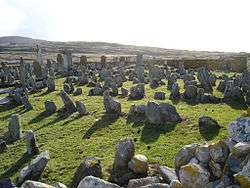
There are many visible historical and archaeological remains on Berneray. These stem from the fact that the island has been populated for over 5,000 years by a number of native and invading races, due to the fertile lands.
Older historical features include Cnoc Na Greine (Hillock of the Sun), a circle of stones on one hilltop that was the supposed center of pre-Christian sun worship, and Cidhe mor Mhicleoid (Big Quay of MacLeod), a mostly submerged Viking pier close to the Youth Hostel. Near the south of the island is 🌍 Beinn a'Chlaidh (Hill of the Graveyard), a pagan site with a standing stone eight feet in height. A chapel dedicated to St. Columba was built on the site in the 6th century and later plundered by the Vikings.
To the west of the standing stone is A'Chiste Chloiche, the remains of a chambered cairn from the Bronze Age where kings were buried with their Ulaidh (treasure). 125 yards to the southwest of the standing stone is Leac an Righ (Stone of the King). This is a stone with the imprint of a human foot and inscriptions similar to the stone at Dunadd on mainland Scotland where kings were crowned.
On the machair are a collection of large stones. These were used in trials held by the Vikings; one of the stones is known as the chairstone, and opposite is another where archaeologists speculate that the accused presented his case. Strange curvatures of the land nearby indicate possible sites of Viking burials, as yet unexplored.
To the west, nearer the beach, is Uaigh an Innseanaich (Grave of the Indian). In 1918 a drowned man was washed ashore on the West Beach. He was buried nearby on the machair, a stone placed at his head and feet, but the exact location has now silted over.
Cill Aiseam, the churchyard of St Asaph (a 7th-century British bishop and follower of St Kentigern) can be located near to the youth hostel. Nearby is an ancient well, the era of which is the source of disagreement among archaeologists. Also nearby is Clach nan Coinnlean (Stone of the Candles); coffins were rested on this stone, on their way to 🌍 Cladh a'Chambuir, the old cemetery dramatically set on the south side of Ben Leva.
- 🌍 The Armoury. is a deserted building and the birthplace of Sir Rory Mor (Norman MacLeod), a scholar who fought at the battle of Worcester. The Latin plaque above the doorway reads: "Hic natus est ille illustris Normanus MacLeod de Berneray eques auratus".
On the extreme southwest point of the island, at the end of the West Beach, is Braighe na Ceilp (Breastwork of the Kelp). Just above the shoreline stones have been evenly settled into the ground rectangulary to support the seaweed for drying and burning. This was a thriving industry for some years and, as a result of immigration, the population increased to 712 in 1841. However, by 1851 it had declined to 410, due to evictions and the cessation of the kelp industry. Nearby is 🌍 Cnoc nan Claigeann (Hillock of the Heads), an unnatural rise probably built by ancient Celts who collected heads of invaders. The ruins of a shepherd's bothy stands on the summit.
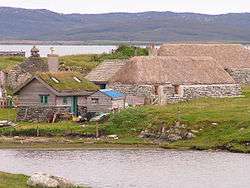
Blackhouses, some deserted and some ruined, can be seen in all parts of the island. These were generally built with double dry-stone walls packed with earth and wooden rafters covered with a turf roof, although reed thatch was occasionally used as the roofing material. The floor was usually flagstones or packed earth and there was a central hearth for the fire. The blackhouse was used to accommodate livestock as well as people, animals at one end and people at the other with a partition in between. There was no chimney for the smoke to escape; instead, the smoke made its way through the roof. The structures, though requiring constant maintenance, were often extremely sturdy in order to survive winter storms. After around 1850, houses were built with single walls and were known as taighean geala or white houses.
As people moved into more modern dwellings with conveniences such as running water and central heating, the blackhouse tended to go out of use, and many ruined or roofless examples can be seen around Berneray. However, blackhouses are increasingly being restored for habitation.
The most visible signs of previous life are the parallel lines that turn around the sides of some of the hills. These are called lazybeds, and were the strips where potatoes were planted in the 18th and 19th centuries to feed the much larger populations of the times.
- 🌍 Giant MacAskill Monument (This is on the south coast of Berneray; follow the machair road to the end and walk about half a mile further till you come to the monument.). The most well-known is probably the site of the house where the giant Angus MacAskill was raised. Giant MacAskill, (Angus Mor MacAskill, (1825-August 8, 1863) was known as the world's largest "true" giant (normal proportions, no growth abnormalities), reaching a height of 7 ft 9 in. The 1981 Guinness Book of World Records lists Angus as the tallest natural giant who ever lived, the strongest man who ever lived, and the man having the largest chest measurements of any non-obese man (80 inches). Many descendants of his family still live on the island and are noticeably tall people. There is a museum about him in Dunvegan on Skye.
Nearby islands
Berneray can be used as a base for exploring nearby small, unpopulated islands by boat. Many of these islands have old ruins and pleasant beaches, ideal for non-exerting walking and picnics. Boat trips are available at the fishing harbour; ask there or examine the latest notices on the island noticeboard. Trips are weather dependent, and prices are negotiated with the boat owner/skipper. As a guide, a boat full of people going to an island such as Pabbay for a whole day may cost around £120. Some boat owners offer short trips around the local bay to see the seals (very) close up; prices start at around £6.
Do
- Outdoor activities include boat trips to nearby islands to see the seals close up, windsurfing, canoeing, and kayaking. Watersports are generally self-organized. Surfers have recently started surfing off the West Beach of Berneray in small numbers due to the waves on even calm days. The sea temperature means that a wetsuit is recommended for all watersports. There are no sporting facilities as such, apart from a set of football goal posts on the machair.
- You can also help out with various crofting activities such as "tattie hawking" (collecting potatoes), sheep shearing, cattle herding and fishing. Bring clothing for mucky work!
- Ceilidhs ("KAY-lee", traditional Gaelic music and dancing) are held frequently in the community hall.
Events
- Berneray Week. Third week in July. An island event which consists of a number of sporting, Gaelic and festive events. Includes Ceilidhs, a beach barbecue and a traditional concert on different evenings. Daytime events include a sandcastle making competition for both adults and children, and a 10 kilometre running race around the island. Events individually priced..
- The Christmas meal in the hall is open to residents and visitors alike.
- Notices for Ceilidhs and all other local events are put on the window of the shop, and on the island noticeboard which can be found at the only road junction of the island.
Buy
- 🌍 Berneray Shop (700 yards from Berneray ferry terminal and the causeway), ☎ +44 1876 540288. M-Sa 9AM-5:30PM, closes earlier in winter. Stocks a large selection of packaged food and fresh local produce, as well as maps, books, outdoor clothing and hardware products. It has a very useful section for traveling (cyclists, walkers, drivers) needing to repair or replace something.
- 🌍 Coralbox, 3 Backhill (Above fishing harbour), ☎ +44 782 609 7599, e-mail: coral-box@hotmail.com. M-Sa 10:30AM-5PM, restricted opening in winter. Coralbox is a small gift shop that stocks a range of gifts from local handmade Hebridean products to souvenirs, selection of greeting cards & local photograph items such as coasters, mugs, keyrings etc. Also stocks a wide range of nautical- and island-themed items. Also has a takeaway hot drinks machine.
- 🌍 Berneray Post Office (Backhill near the seal viewing area). M Tu Th F 9:30AM-1PM. The Post Office is well stocked.
- 🌍 Roadside Eggs in Borve. Eggs are sold from a roadside honesty box. Hens eggs, with also occasionally goose or duck eggs in season.
- RBS Mobile Bank (ask locally for best point to wait). Tu noon. A Royal Bank of Scotland in a van visits the island once a week.
Eat
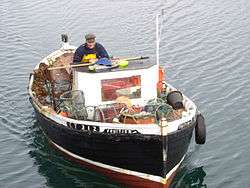
Visitors looking for a sit down restaurant have but one option, although a fun alternative is to hang around the fishing harbour on the east side and purchase fresh catch (crabs, prawns, fish, lobster) from one of the fishermen. Outdoor picnic spots include a sign-posted "picnic" site on the machair, as well as any one of the beaches. A fish van visits the island once a week on Tuesdays in the early afternoon, selling a wide variety of locally-caught and fresh fish. Prices tend to be about the same as supermarket prices.
Alternatively, there are several places to eat in Lochmaddy, which is connected to Berneray by a frequent daytime 10-mile bus service.
- 🌍 Berneray Bistro (700 yards from Berneray ferry terminal and the causeway, connected to Berneray Shop), ☎ +44 1876 540288. M-Sa 10AM - 4PM, 5:30PM - 8:30PM. Serves sandwiches, soups, melts, and cakes during the day, and 3 course dinners in the evening. Often busy - booking recommended for evening meals. soup £4.50, mains from £13.
Drink
There are no drinking establishments on Berneray, but Berneray Shop sells beers, wines, and spirits.
A Scottish tradition is the "carry out", where people will buy a selection of beers and take them to their house for a spontaneous party. People staying in the Youth Hostel often have evening drinking and social parties. Ceilidhs (parties with local music and dancing that start in the late evening and go on through the night) are frequently held, where there is much drink and socializing, but no trouble. These are a good place to drink, meet local people, learn some dance moves and a few words of Gaelic.
Sleep
There are a number of options for self-catering and bed and breakfast accommodation on Berneray. The tourist information office in Lochmaddy (a ferry port) 10 miles away on North Uist has details of accommodation in various places within a short distance of Berneray.
Bed and breakfast
- 🌍 Brightwater B&B, ☎ +44 1876 540273. 3-room B&B in a recently built seaside bungalow with the possibility of an evening meal. from £40.
- 🌍 Seal View, ☎ +44 1876 540209. Offers 1 family room, sleeping up to four (with private bath). Panoramic views of sea, mountains and basking seals. £35 for one person, £50 for two, £10 for additional guests.
Self-catering
- 🌍 Borve Cottage (in the west of Berneray), ☎ +44 1876 540224. 3 doubles and 1 single; kitchen, living room. Most rooms have views over the machair to the cockle beach. June to September: £250 per week, October to May: £200 per week, electricity extra.
- 🌍 Cnoc an Dudain, 7 Ruisgarry, ☎ +44 1288 341105. 1 bedroom thatched blackhouse on the shore. £350 - £580 per week.
- 🌍 The Smiddy, Burnside Croft, Borve, ☎ +44 1876 540235. Small cottage (sleeps 2) for rent. from £580 per week.
- 🌍 30 Backhill (on the east coast of Berneray just before the church), ☎ +44 1967 402147. Rebuilt black house with thatched roof right next the sea. £390-790 per week.
- 🌍 Laimraig Thatched Cottage, ☎ +44 1876 540283. Thatched cottage sleeping 4 with separate utility building. £500-750 per week.
Other more occasional rooms become available for summer only; ask in the island shop for details of what accommodation is available. Accommodation tends to be cheaper than on the mainland or more tourist-oriented islands.
Hostel
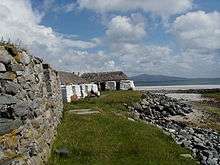
- 🌍 The Youth Hostel. Operated by the Gatliff Trust on behalf of the SYHA. Has 20 beds, and is world-famous for being in a most spectacular location. Perched on the north east side of the island, the hostel is at the end of the east beach, and has views over the Sound of Harris to Harris, mountains on the mainland, and Skye. £16 for a bed (+£2 for sheet sleeping bag hire), or £8 if you're under 18. It is also possible to camp here for £10/person/night.
- 🌍 John's Bunkhouse (near the Cockle Beach), ☎ +44 1876 540229. A new 8-bed bunkhouse, which opened in May 2018. The 3 bedroom bunkhouse is in an old blackhouse, which has been refurbished with a modern roof. Adult bed £25.
Camping
Wild camping is possible. Please leave no litter or other trace of your stay. You can camp at the Youth Hostel (see above). Alternatively camp elsewhere and use the facilities at the fishing harbour (payable shower, toilets), and at the ferry terminal (toilets and facilities for emptying caravan toilets). Most campers and motorhomes pitch near the East Beech.
Boat
Sailors can also drop anchor in the shallow waters around Berneray. Note that at very low tides (usually in the Spring) various rocks are uncomfortably close to the surface; ensure that you have a detailed chart.
Cope
Mobile phone reception can be poor, but with most networks a signal can be obtained by moving around and gaining some height, but it may not be necessary to walk right to the top of the hill. Data connections are slow and intermittent. Limited WiFi is available in the Harris ferry waiting room.
- 🌍 Payphone (Next the harbour). A BT payphone that takes coins - 60p minimum charge using a maximum of four coins, but this does give a long UK call.
- 🌍 Nurse's Cottage. The Information Centre doubles as a historical display centre and is open during the summer months and manned by local volunteers. It offers broadband internet access (WiFi and a public desktop PC) for a small fee. It is housed in a building formerly used by the island's nurse.
- 🌍 The Church of Scotland, Church Road. Congregation holds services on the 1st, 3rd and 5th Sunday of each month at noon, on other Sundays there are services in Lochmaddy. The service is generally in English, with one psalm in Gaelic. Psalms are sung in the Hebridean style with no music.
Go next
- Cross the causeway to North Uist, then south to Benbecula, South Uist, Eriskay and Barra.
- Take the ferry to Harris then north to Lewis.
- Take the ferry from Lochmaddy in North Uist to Uig on Skye, then the bus to Kyle of Lochalsh, Inverness or Glasgow.